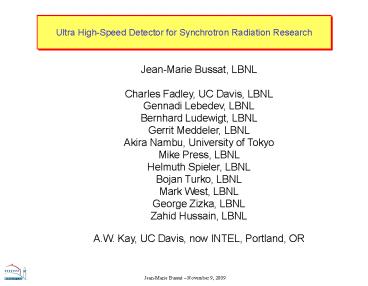JeanMarie Bussat, LBNL - PowerPoint PPT Presentation
1 / 15
Title:
JeanMarie Bussat, LBNL
Description:
10 x 40 mm active area. 768 channels. 48 m pitch ... 6 x 128 ch = 768 ch. BMC chips. PC interface (National Instruments) HV. Analog power ... – PowerPoint PPT presentation
Number of Views:55
Avg rating:3.0/5.0
Title: JeanMarie Bussat, LBNL
1
Ultra High-Speed Detector for Synchrotron
Radiation Research
Jean-Marie Bussat, LBNL Charles Fadley, UC
Davis, LBNL Gennadi Lebedev, LBNL Bernhard
Ludewigt, LBNL Gerrit Meddeler, LBNL Akira Nambu,
University of Tokyo Mike Press, LBNL Helmuth
Spieler, LBNL Bojan Turko, LBNL Mark West,
LBNL George Zizka, LBNL Zahid Hussain, LBNL A.W.
Kay, UC Davis, now INTEL, Portland, OR
2
Motivation
- Various experiments will benefit from up to GHz
linear detection in 1D at ?50 ? resolution - ?10100x faster data rates (?1 msec/spectrum,
100?sec sampling time) - --allows time-resolved (1 ms?100 ?s)
photoelectron spectroscopy, - diffraction, holography
- ? More efficient beamtime usage
- --no need to reduce photon flux/close
slits to avoid non-linearity - and saturation
- ? Higher quality data
- -- better linearity, no need for
after-the-fact correction - ? New experiments
- --realtime energy dispersive transmission
x-ray absorption - spectroscopy
- --time-resolved soft x-ray resonant
magnetic scattering x-ray - emission spectroscopy
3
Detector Architecture
Power supplies
Electrons or photons
HV
Microchannel plates-MCPs (40 mm x 10 mm)
to ASICs
LV
Electron cloud
Collectors (768 strips with 48 ?m spacing)
48µm
Preamplifier
Data acquisition board (DAQ)
Counter
Discriminator
Readout
Analog Front end
Binary readout
4
Comparison to Existing Detectors
Energy
Channel
No.
Maximum
Additional
resolution
Detector
width
chan-
overall
comments/
D
E/E
(microns)
nels
countrate
features
-4
(x 10
)
Highly linear,
768
1D--LBNL
lower noise,
50
1.3
gt2.0
GHz
(128x
programmable,
Detector 2
6)
more robust
768
Highly linear,
1D--LBNL
50
1.3
(64x
1.0
GHz
proved
Detector 1
principle
12)
Facility project,
1D--
Elettra
320
8.0
96
in use, much
5 MHz
(Italy)
slower
Ions, simpler
1D--
preamp
,
Aberystwyth
20-40
25
0.7
192
10-20x lower
MHz
(Wales)
sensitivity for
electrons
2D--
Highly non-
360 x
Commercial
110x110
2.9
lt1.0 MHz
linear,
1/1000
360
CCD
rates
(
Scienta
)
2D--
Commercial
Linear to only
256 x
400x400
10.0
lt1.0 MHz
resistive
256
300 kHz
anode
(
Quantar
)
5
First Prototype Detector -- Experimental Test
results
1 GHz
First generation version with GHz overall count
rate detector
A.W. Kay, Ph.D. thesis (UC Davis, 2000)
6
Design of Second Generation Detector
?Improvements from first generation --More
robust design --Increased count rate capability
(via CAFE-M) --Reduced size (to fit various
existing spectrometers) --Improved readout
system (via new chip) ?Use of special
expertise available at LBNL --High energy
physics detector design ?Detector
architecture --Analog front-end ? Reuse a
chip developed for silicon strip
detector readout (CAFE-M from ATLAS
experiment) --Counter and binary readout ?
Custom-designed BMC chip compatible with
CAFE-M and allowing
deadtime-less readout of all channels
(Design resource used 1.5 FTE during 5
months)
7
Custom chips
CAFE-M, analog front end Gain at the Comparator
100 mV/fC Peaking Time 25 ns Output Pulse
Amplitude 100 ?A Double Pulse Resolution (Qs4
fC) 50 ns Time Walk (Qs1.25 - 10 fC) lt 15
ns Supply Voltage 3.5 V Power Dissipation
per Channel 1.2 - 1.8 mW Number of
Channels 128 Includes calibration pulse
generator
8
Detector Hybrid
Smaller diam. (e.g. fits Scienta SES 2002, other
electron spectrometers)
Counter/readout (BMC)
Amplifier/Discriminator. (CAFE-M)
10 x 40 mm active area 768 channels 48 µm pitch
48 mm
Connections to optical interface and power supply
9
Detector Assembly
Before MCP installation
Ready for first tests
10
First Tests with UV lamp
Non uniform light source Uncalibrated detector
11
First Tests with (Non-Uniform) Electron Flux
Illumination
12
Maximum Countrate?
Shape monotonically increasing ? No signs of
saturation to gt 2 MHz
2 MHz
13
Summary
? First generation validated concept ? 1 GHz
linearity, 700 channels, ?75 ? resolution ?
Second generation tests started on March 1st,
2003 - Complete system (detector, power supply,
DAQ, and software) operational -
Mechanically robust - Able to detect UV light
and electrons over all channels - First
measurements indicate expected characteristics
can be achieved ?2 GHz
linearity, 768 channels, 75 ? resolution -
Further tests continuing, installation at the ALS
in April 03
Additional information available at
http//www-eng.lbl.gov/jmbussat/ALS
14
Second generation detector architecture
e- or h?
Vacuum wall
To spectrometer supply
768 collector strips
MCPs
- HV
Custom Power Supply
2 kV
HV
Collector voltage (0-100 V)
Ampl.
Café-M chips
(Floating at - HV retard voltage of
spectrometer 0 to -1.5 kV
6 x 128 ch 768 ch
Analog power
Discr.
DACs
Digital power
BMC chips
PC interface (National Instruments)
Commands in Data out Clock
Buffered counter
Triple fiber-optic interface (HV isolation)
Serial link (40 MHz)
DAQ board (custom)
15
Detector AssemblyConceptual drawing































